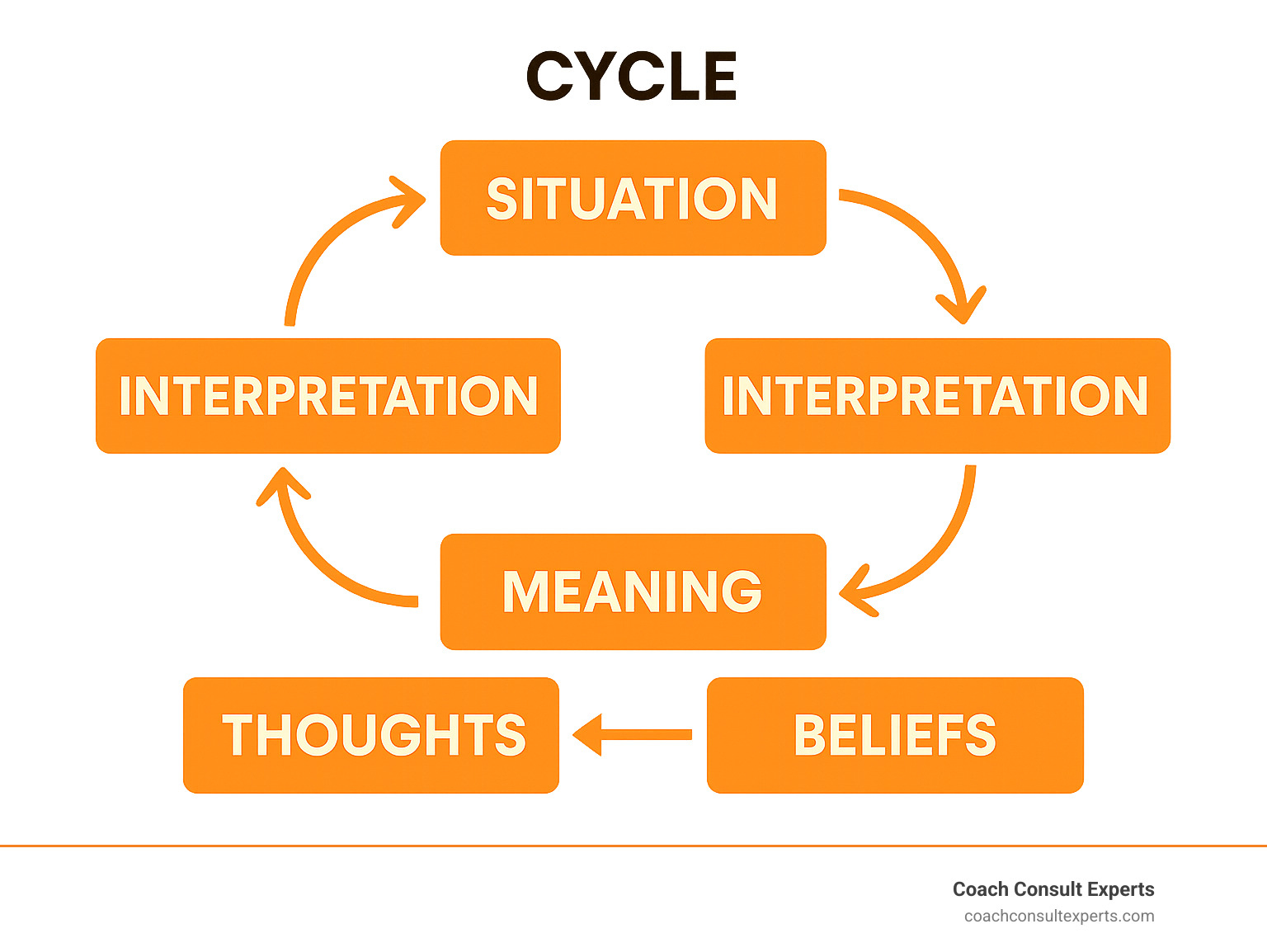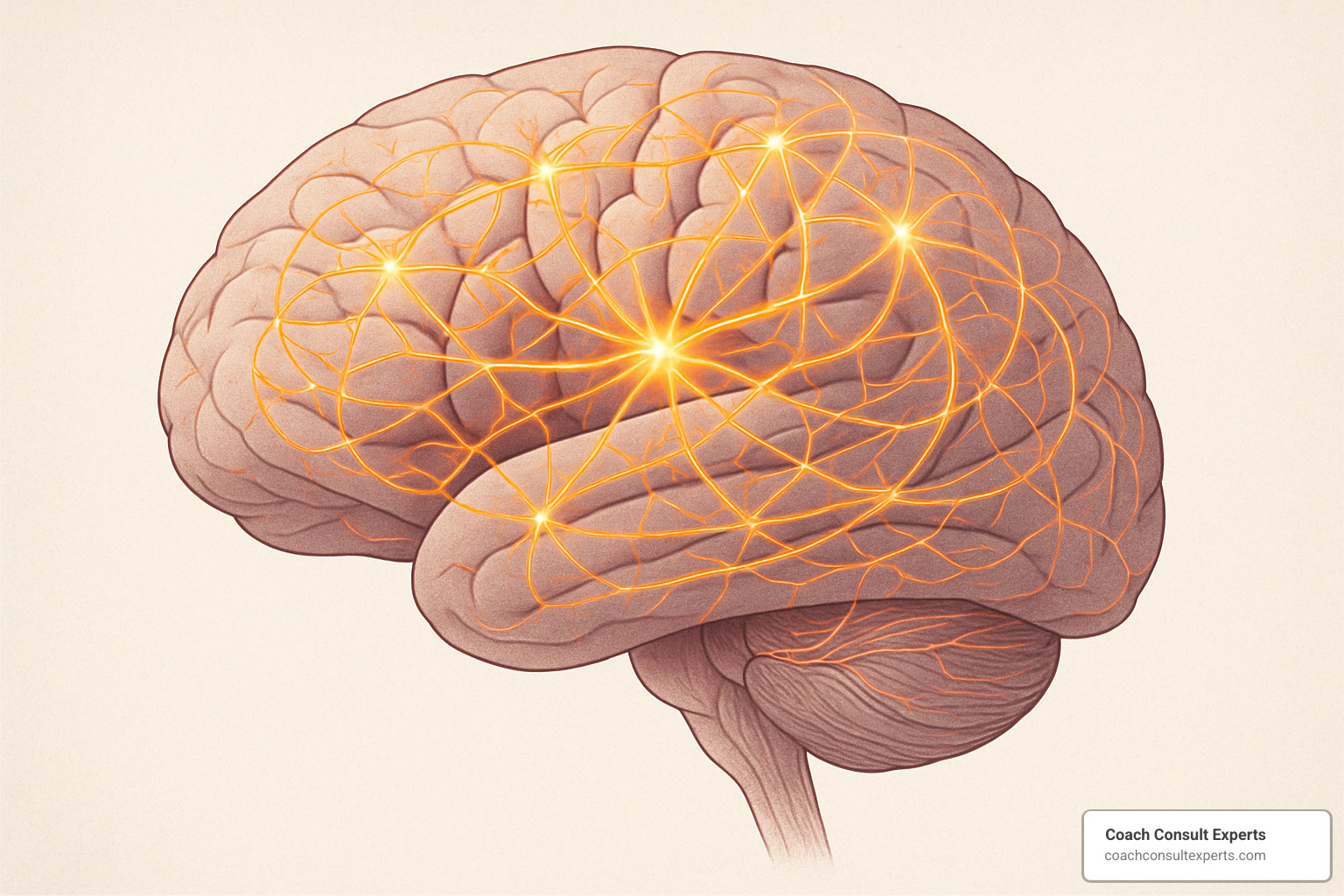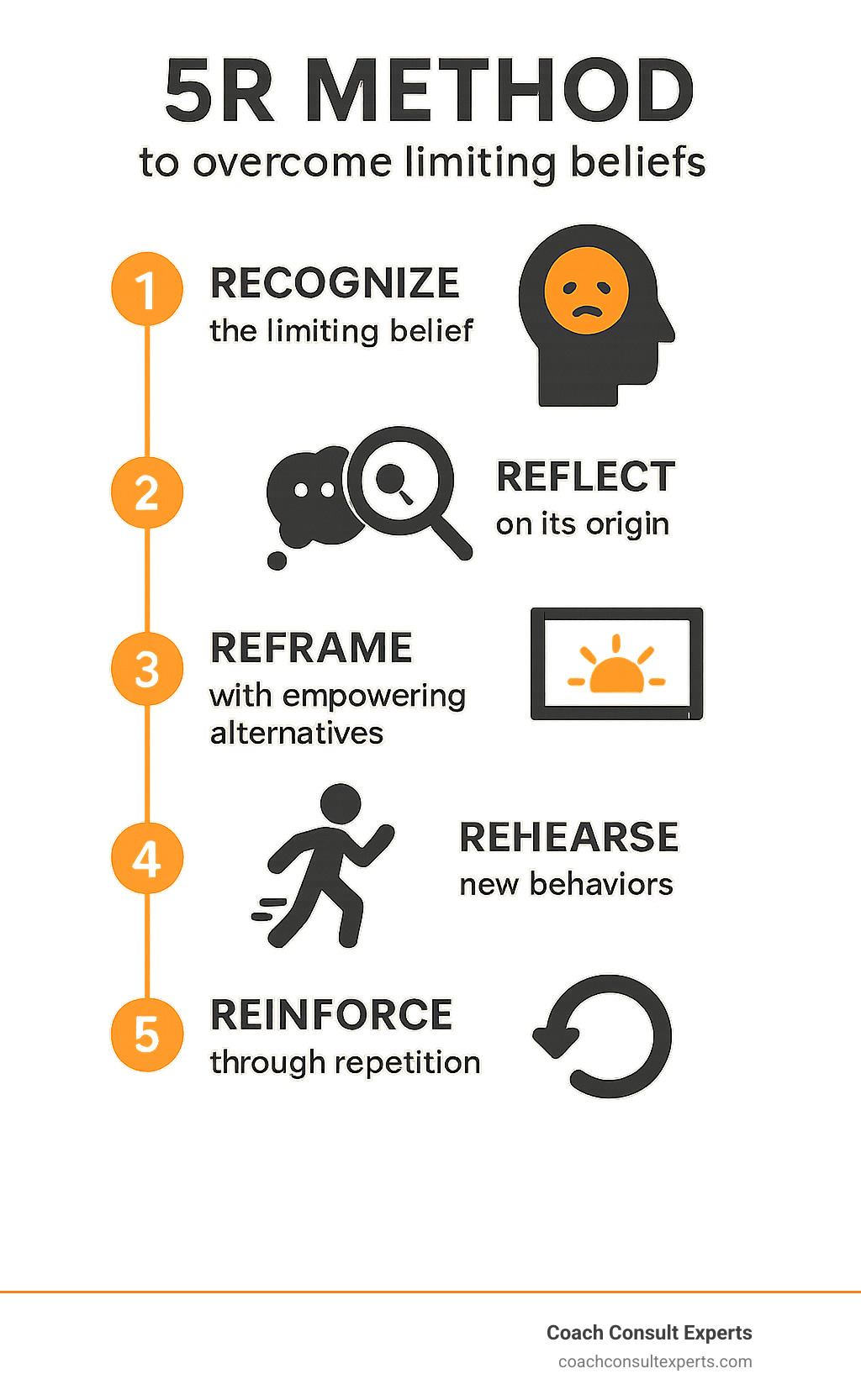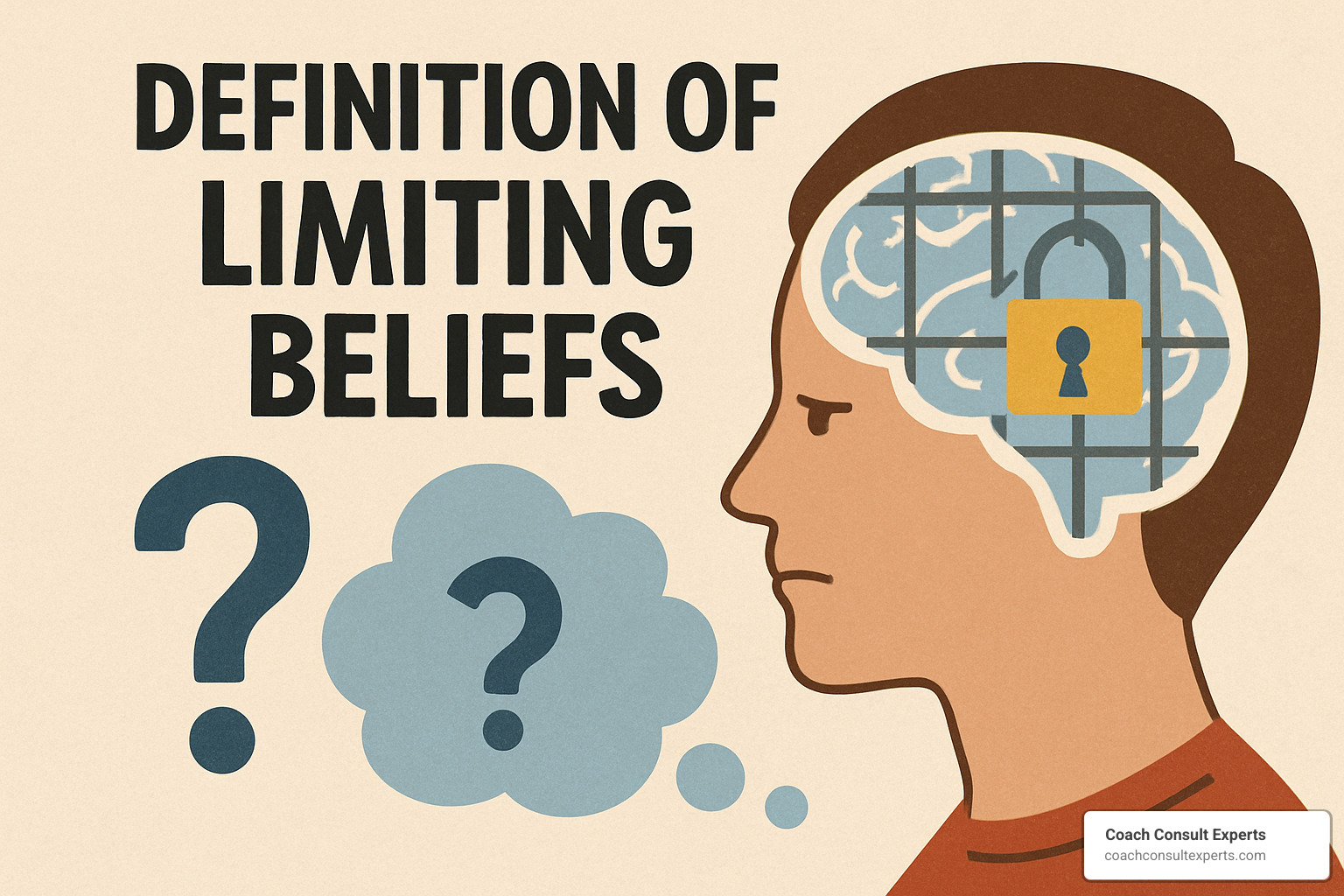Definition of Limiting Beliefs: 7 Powerful Ways to Break Free
What Are Limiting Beliefs and Why They Matter
The definition of limiting beliefs is surprisingly simple: they are thoughts, convictions, or assumptions we hold as absolute truths that restrict our potential and prevent us from taking action toward our goals.
Quick Definition:
- What they are: Subconscious stories we tell ourselves about our abilities, worth, or potential
- How they work: Filter our perception and limit our choices without us realizing it
- Why they persist: Our brains treat them as facts, even when they’re based on outdated or false information
- Common examples: “I’m not smart enough,” “I don’t deserve success,” “I’m too old to change careers”
Think of limiting beliefs as invisible chains in your mind. Research shows our brains can produce up to 50,000 thoughts per day, and 95% of these thoughts are repeated daily. Many of these repeated thoughts become the limiting beliefs that shape our reality.
These beliefs create a cycle: Our words become thoughts, thoughts become beliefs, beliefs shape our mindset, mindset drives our actions, and actions determine our results.
Research shows that employees with limiting beliefs are 21% less likely to receive positive performance evaluations and often struggle with confidence in workplace situations like asking for raises or sharing ideas in meetings.
But here’s the good news: limiting beliefs aren’t permanent. Understanding their definition is the first step toward breaking free from these mental constraints and opening up your true potential.
I’m Coach Mary Chege-Kamau, a PCC-certified coach with over two decades of experience helping thousands of professionals transform their lives by understanding and overcoming limiting beliefs that hold them back.

The Definition of Limiting Beliefs
Picture this: you’re standing in front of a door marked “Your Dreams,” but there’s a voice in your head whispering, “You’re not smart enough to walk through.” That voice? It’s a limiting belief, and it’s been running the show longer than you might realize.
The definition of limiting beliefs goes beyond simple negative thoughts. These are deeply held convictions we’ve accepted as absolute truth about ourselves, others, or the world around us. They’re like having sunglasses permanently glued to your face – everything you see gets filtered through their dark lens.
Limiting beliefs don’t announce themselves with fanfare. They slip into our minds disguised as “common sense” or “just being realistic.” When you catch yourself saying, “I could never do that” or “People like me don’t succeed,” you’re hearing a limiting belief speak.
What sets limiting beliefs apart from regular thoughts is their rigidity. While healthy skepticism helps us make smart decisions, limiting beliefs slam the door shut before we even peek inside.
Think of your brain as an overprotective parent. It developed these beliefs to keep you safe from disappointment, rejection, or failure. The problem? That same protective mechanism now treats a job interview like a saber-toothed tiger.
The most insidious part is how they masquerade as personality traits. “I’m just not a math person,” “I’m naturally shy,” or “I don’t have a business mind” sound like facts, but they’re actually learned stories we tell ourselves.
| Regular Beliefs | Limiting Beliefs |
|---|---|
| Based on current evidence | Based on outdated assumptions |
| Open to revision | Treated as unchangeable facts |
| Encourage growth | Restrict potential |
| Expand possibilities | Narrow choices |
Why Understanding the Definition of Limiting Beliefs Matters
Understanding the definition of limiting beliefs is like getting the key to your own prison cell. When you recognize that these aren’t facts about your abilities but rather learned patterns, something magical happens. The beliefs lose their power over you.
Self-awareness becomes your superpower. Most limiting beliefs operate in stealth mode, quietly steering your decisions without you noticing. They’re the reason you don’t speak up in meetings, avoid networking events, or talk yourself out of applying for that promotion.
Every time you shrink back because you “don’t belong,” every dream you abandon because you’re “not cut out for it” – these moments add up to a life half-lived.
Research shows that many employees lack confidence to share ideas, ask for raises, or fully engage at work. This isn’t a character flaw – it’s limiting beliefs whispering that their contributions don’t matter.
The beautiful truth is this: once you understand what limiting beliefs really are, you can begin to question them. And once you question them, you can change them.
Common Examples That Fit the Definition of Limiting Beliefs
“I’m not good enough” tops the charts as the most common limiting belief. It’s like a Swiss Army knife of self-sabotage – versatile enough to ruin job interviews, relationships, and dreams with equal efficiency.
Impostor syndrome tricks high achievers into attributing their wins to luck instead of skill. You’re convinced everyone will find you’re a fraud, despite your track record of success.
Perfectionism is actually the belief that anything less than flawless equals failure. It paralyzes people into inaction because if you can’t do it perfectly, why try at all?
Money blocks like “money corrupts people” or “I don’t deserve wealth” keep people stuck in financial struggle, even when opportunities for abundance surround them.
Age-related beliefs use the calendar as a weapon against your potential. Whether it’s “I’m too old to start over” or “I’m too young to be taken seriously,” success doesn’t check your birth certificate before showing up.
Origins & Evolution of Limiting Beliefs
Have you ever wondered why certain beliefs about yourself feel so absolutely true, even when evidence suggests otherwise? The answer lies in understanding where these mental barriers come from.
Most limiting beliefs can be traced back to our earliest years. As children, we’re incredibly vulnerable to the messages we receive. Our young brains haven’t yet developed critical thinking skills to question what we’re told, so we absorb everything like little sponges.
Childhood conditioning forms the bedrock of our belief system. When a frustrated teacher snaps “You’ll never amount to anything” or a parent constantly warns “Don’t get your hopes up,” these messages sink deep into our developing sense of self. A single harsh comment from someone we trust can echo in our minds for decades.
Societal norms weave themselves into our consciousness from birth. We pick up messages about what’s possible for people who look like us, come from our background, or belong to our gender. These cultural scripts can feel like natural law, but they’re really just learned assumptions.
Past failures create sticky limiting beliefs because they feel backed by hard evidence. If you bombed a job interview once, your brain might conclude that you’re “just not good at interviews.” Our protective minds generalize single experiences into universal truths about our abilities.
Trauma imprints work similarly but with more intensity. When we’re hurt, our brains create protective beliefs to shield us from similar pain. These beliefs might have saved us once, but they often outlive their usefulness.
Every time we think a thought, we strengthen the neural pathway associated with that thought. Neural pathways make our limiting beliefs feel increasingly real and automatic over time.
Our brains also have a built-in negativity bias – we’re naturally wired to notice and remember negative experiences more than positive ones. This makes limiting beliefs feel more “true” than empowering ones.
But here’s where hope enters: Scientific research on brain plasticity reveals that our brains remain changeable throughout our entire lives. This neuroplasticity means we can literally rewire our thinking patterns, no matter how long we’ve held certain beliefs.

The Role of Repetition in Cementing Limiting Beliefs
Your brain produces around 50,000 thoughts per day, and 95% of those thoughts are repeats from the day before. You’re running the same mental programs over and over again, often without realizing it.
This repetition is your brain’s way of conserving energy. Rather than analyzing every situation from scratch, your mind creates cognitive shortcuts based on established patterns. While this efficiency helps you steer daily life, it also means your limiting beliefs can run on autopilot.
Your reticular activating system (RAS) acts like a personal filter, highlighting information that confirms what you already believe while ignoring contradictory evidence. If you believe you’re terrible at networking, your RAS will zoom in on every awkward pause while filtering out the meaningful connections you actually made.
Tracing Your Personal Limiting Beliefs Back to First Memory
Want to open up the mystery of your own mental barriers? The key lies in becoming a detective of your own mind.
Journaling offers one of the most powerful paths. When you write down your limiting beliefs and explore their history, you often uncover surprising connections. Try asking: “When did I first start believing this about myself?”
The downward arrow technique helps you dig beneath surface concerns to uncover core beliefs. Start with any worry, then keep asking “If this were true, what would that mean about me?” until you hit bedrock.
Family scripts often provide the original blueprint for our limiting beliefs. The unspoken rules about money, success, relationships, and self-worth that we absorbed from our families can continue directing our lives decades later.
This exploration connects beautifully with what we explore in Honor Your Discontent – that persistent feeling that there’s something more waiting for you beyond your current limitations.
Impact: How Limiting Beliefs Sabotage Personal & Professional Growth
When you truly understand limiting beliefs, you begin to see their fingerprints everywhere – and the damage they cause is both heartbreaking and preventable.
Sarah, a brilliant marketing professional, consistently turns down speaking opportunities because she believes she’s “not an expert.” Meanwhile, her less experienced colleague confidently presents good but not groundbreaking ideas. Guess who gets promoted? This isn’t about fairness – it’s about how limiting beliefs create invisible barriers that feel completely real.
Your self-confidence becomes the first casualty. When you repeatedly tell yourself you’re not smart enough or worthy enough, your brain starts treating these thoughts as facts. This creates a self-fulfilling prophecy – you perform poorly because you expect to, which then “proves” your limiting belief was right.
The workplace becomes a minefield when limiting beliefs take hold. Career progression stalls not because of lack of talent, but because of internal barriers. Research reveals a confidence crisis in the workplace where talented people avoid putting their ideas forward, never ask for pay raises, and stay silent in meetings.
Think about your last team meeting. How many brilliant ideas never got shared because someone believed they weren’t “qualified” to speak up? Teamwork suffers when people self-censor based on false beliefs about their value.
Innovation dies when people believe “that’s not how we do things here” or “I’m not creative enough.” Organizations miss out on breakthrough ideas not because their people lack creativity, but because they lack belief in their own creative abilities.
The emotional toll is perhaps the most heartbreaking aspect. Emotional well-being crumbles under the constant weight of an internal critic that never takes a day off.

Ripple Effects on Team Culture and Leadership
Limiting beliefs don’t stay contained within individuals – they spread like invisible viruses throughout entire organizations.
Psychological safety becomes impossible when team members believe they can’t make mistakes, ask questions, or challenge the status quo. Teams need people who believe their voice matters and that taking thoughtful risks is encouraged.
The tragedy of idea sharing in many organizations isn’t that people don’t have good ideas – it’s that they believe their ideas aren’t worth sharing. Brilliant solutions get buried because someone thinks, “I’m sure they’ve already thought of this.”
Pay-rise negotiations become nearly impossible when employees believe they don’t deserve better compensation. This perpetuates inequality and prevents talented people from being fairly rewarded.
Leadership effectiveness plummets when unconscious bias rooted in limiting beliefs affects decision-making. When leaders believe certain people “aren’t leadership material,” they create systemic barriers that waste human potential.
This connects directly to our work on accessing your genius – helping individuals and teams recognize that their unique strengths and perspectives are exactly what the world needs.
The good news? Once you understand how limiting beliefs operate, you can begin to dismantle them. Every belief that holds you back was learned, which means it can be unlearned and replaced with something that serves your growth.
From Awareness to Action: Strategies to Break the Chains
Knowing what limiting beliefs are is only half the story. The next step is doing something about them.
Mindfulness helps you notice a belief the moment it appears so you can decide whether to keep it or let it go.
Cognitive reframing swaps the old script for a new one. “I can’t handle public speaking” becomes “I’m learning to share my ideas in public.”
Affirmations reinforce that new script. Make them specific: “I earn opportunities equal to my skills.”
Visualization lets your brain rehearse success before it happens, strengthening neural pathways that support change.
Behavioral experiments give you data. One real conversation at a networking event can disprove years of “I’m bad at networking.”
Mentor or coach support speeds everything up because an outside eye can spot blind spots you miss.


At Coach Consult Experts our VIP coaching programs combine these techniques with rapid subconscious change so you rewrite the stories that have been running your life. They also align with our Four Steps to Activating Your Abundance framework.
Redefining Limiting Beliefs Through Daily Practice
Change happens through small, repeatable actions:
- Belief journaling: capture limiting thoughts and challenge them on paper.
- Evidence logging: write down every win that contradicts the old story.
- Growth mindset cues: place sticky notes or phone reminders that say “I’m learning.”
- Celebratory micro-wins: acknowledge each time you act in spite of fear.
Leveraging Support Systems
- Peer feedback reflects strengths you may overlook.
- Mastermind groups make growth the norm.
- Therapy vs. coaching: therapy heals the past; coaching moves you forward.
- Safe accountability means people who will call you out with kindness.
Practical Exercises & Tools
Below is a compact toolkit you can start using today. None of these require special equipment – just intention and a few minutes of focus.
- Socratic questioning: Ask, “What proof supports this belief?” and “What contradicts it?”
- Downward-arrow worksheet: Keep asking “If that were true, what would it mean about me?” until you reach the root belief.
- Guided visualization: Close your eyes, replay the situation, and picture yourself succeeding.
- Mantra deck: Write empowering statements such as “I connect easily with like-minded people” on index cards and read them daily.
- Journaling prompts:
- Which belief about myself am I ready to release?
- What would I attempt if success were guaranteed?
- How has this belief protected me before, and how is it limiting me now?
- What recent evidence disputes my most persistent limiting belief?
- Who benefits when I share my full potential?

Quick 10-Minute Routine
- Write one limiting belief (3 min).
- Challenge it with contradicting evidence (3 min).
- Reframe it into a supportive belief (3 min).
- Read the new belief aloud and move on with your day (1 min).
Tie the routine to an existing habit (morning coffee) and use a timer so you stay on track. Consistency beats perfection every time.
Frequently Asked Questions about Limiting Beliefs
Let’s address the most common questions I hear from clients about the definition of limiting beliefs and how to work with them effectively.
What’s the fastest way to spot a limiting belief in real time?
Your inner voice gives you the biggest clues. Listen for language patterns that sound absolute or permanent. When you catch yourself saying “I always mess up presentations” or “I’m just not a numbers person,” you’ve likely stumbled onto a limiting belief in action.
The word “just” is particularly sneaky. “I’m just not good at networking” or “I just don’t have what it takes” – these seemingly innocent phrases often mask powerful beliefs that keep us stuck.
Watch for excuse-making patterns too. When you automatically decline opportunities or avoid challenges, ask yourself what you’re really afraid of. That fear usually points straight to the underlying belief. If you won’t apply for a promotion because you’re “not ready yet,” the real belief might be “I don’t deserve success.”
Your body also sends signals. Notice when you feel that familiar tightness in your chest, the sinking feeling in your stomach, or sudden fatigue when facing certain opportunities. These physical responses often arrive before your conscious mind recognizes the limiting belief at work.
The fastest technique? Pause and ask yourself: “What would I do right now if I believed I was capable and deserving?” The gap between that answer and your current behavior reveals the limiting belief.
Can limiting beliefs ever be helpful or protective?
Absolutely! This is one of the most important aspects of understanding the definition of limiting beliefs – they often started as smart protective strategies.
Think about it: if you were hurt in a previous relationship, developing the belief “I need to be careful about who I trust” makes perfect sense. The problem comes when that reasonable caution transforms into “I can’t trust anyone ever” – now the protection has become a prison.
Some beliefs genuinely serve you. “I shouldn’t drive after drinking” or “I need to research before making big financial decisions” – these aren’t limiting beliefs, they’re wisdom.
The key question is: Does this belief serve my current reality and goals? A belief that protected you as a child might now prevent you from taking healthy risks as an adult. The belief “Don’t speak up or you’ll get in trouble” might have kept you safe in a chaotic household, but it could be sabotaging your career advancement now.
Here’s how to tell the difference: helpful beliefs expand your choices within reasonable boundaries, while limiting beliefs shrink your world unnecessarily. They keep you smaller than you need to be for your current circumstances.
How long does it take to replace a deeply rooted limiting belief?
I wish I could give you a simple answer, but the timeline varies dramatically from person to person. Some clients experience breakthrough moments where a belief shifts almost instantly. Others work steadily for months to fully transform deeply embedded patterns.
Several factors influence the timeline. Childhood beliefs that were reinforced over years typically take longer to change than beliefs formed in adulthood. Emotionally charged beliefs connected to trauma or significant pain require more gentle, patient work than beliefs based on simple misunderstandings.
Your commitment level matters enormously. Clients who practice daily mindfulness around their beliefs and consistently challenge them see changes much faster than those who work on it occasionally.
Most people start noticing small shifts within 2-4 weeks of consistent practice. You might catch yourself questioning a belief that used to feel absolutely true, or notice you’re taking small actions that contradict old patterns.
Significant changes usually emerge over 3-6 months of dedicated work. This is when clients often report major breakthroughs – applying for dream jobs they never thought they deserved, starting businesses they’d always talked themselves out of, or having conversations they’d avoided for years.
You don’t need to completely eliminate a limiting belief to transform your life. Even loosening its grip by 50% can create dramatic changes in your confidence and actions. Progress matters more than perfection.
The beautiful truth about understanding the definition of limiting beliefs is that once you recognize them as changeable stories rather than fixed facts, you’ve already begun the change process.
Conclusion
The definition of limiting beliefs – those invisible chains in your mind that restrict your potential – doesn’t have to define your future. These false assumptions aren’t facts about who you are. They’re simply stories you’ve learned to tell yourself that no longer serve you.
Here’s what we know for certain: your brain’s remarkable neuroplasticity means you can literally rewire these limiting patterns. Every time you challenge a restricting thought, every moment you choose growth over fear, every small action you take despite that inner critic – you’re building new neural pathways that support your success.
The journey from mindset liberation to sustainable growth isn’t always smooth sailing, but it’s absolutely achievable. I’ve witnessed thousands of individuals break through their limiting beliefs to achieve levels of success and fulfillment they never imagined possible. The change happens through consistent small steps taken over time.
At Coach Consult Experts, our approach to rapid subconscious change creates the perfect environment for this kind of profound change. We understand that breaking free from limiting beliefs requires more than just positive thinking – it needs structured support, proven techniques, and a community that believes in your potential.
The beautiful truth is that you don’t need to have all the answers or feel completely confident to begin. You just need to start where you are, with what you have, right now. Whether that means challenging one limiting thought today, finally applying for that promotion you’ve been avoiding, or reaching out for professional support – every action creates momentum.
Your limiting beliefs have had their time in the driver’s seat. Now it’s time for your unlimited potential to take the wheel. The chains in your mind are ready to be broken, and the limitless future you’ve been dreaming of is waiting just beyond your current comfort zone.
If you’re ready to accelerate your journey from limiting beliefs to limitless possibilities, we invite you to explore our VIP coaching programs designed specifically for rapid subconscious change and lasting change. Your breakthrough is closer than you think.




